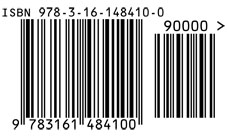
You can also switch between auto-incrementing and manually adding barcodes at any time. You can also always wipe out the barcodes you’ve added, and start over, if you need. Either way works, though, so it’s really down to your personal preference. Especially now that my library is all caught up on barcodes, now when I add a new book, it simply gets the next sequential barcode number. While it’s true that you would need to look at the record, then find the right barcode label to apply to a given book on the sticker sheet, I personally find it to be much easier than manually typing in barcode numbers (or clicking the “add next available barcode” link) as I apply the labels to given books. This feature was primarily created by me ( TimSpalding). If you don’t already have barcodes, the easiest thing to do is to add barcodes to your whole collection, then apply the labels to your books one-by-one. In addition to settings, you can also bulk-add barcodes on this page (under “Actions”). You can edit your Barcode settings at LibraryThing Settings > Barcodes. The rules for barcodes got so large that we gave it it’s own page. There are no rules, except that every barcode must be unique among your books. If you’ve elected for sequential numbers, you can click to get the next one. Editing barcodes in your catalog is as simple as double-clicking. Barcodes come with extensive Barcode Settings.Įditing Barcodes.You’ll also see the barcodes on book-edit pages.“Barcode” (shown below) is under “Physical.” To add the barcode field to your catalog, Edit your Display Styles on LibraryThing Settings > Display Styles.(Now, “where do I get cheap barcode labels?” I hear you ask. But barcode labels make non-ISBN books much easier to inventory. Regular users may not want to barcode every book-scanning the ISBN barcode works great too. Why use barcodes? Besides small collections, barcode inventory may appeal to many regular users. Inventory barcodes go nicely with our other new feature Take Inventory. To prepare for that day, we are releasing another feature that tiny libraries will find useful: comprehensive support for inventory barcodes. In a few short weeks, we’ll be announcing a new feature, specially designed for “tiny” libraries-those small collections found in churches, historical societies, community centers, academic departments, classrooms and so forth. If your books are already barcoded, or if you want to add barcodes, this is the feature for you. We’ve just added barcode support for your books, and a barcode settings page. And we’ll have a big product announcement tomorrow! We’ll place the barcode on your cover so you’ll be ready for sales through any retailer.Two big features in one day? Yup. When you publish with Mill City Press, you’ll receive a combined Bookland EAN and UPC barcode on the back cover of your book, regardless of whether you choose to use your own ISBN or ours. If you want both Bookland EAN and UPC barcodes for your book, it’s possible to combine them into one multi-purpose barcode. A UPC barcode makes it possible to sell your book in other retail establishments, such as drugstores, department stores, and other non-bookstore retailers.

What’s the difference between a Bookland EAN and UPC barcode?Ī Bookland EAN barcode is specific to booksellers. Without the barcode, it’ll be next to impossible for brick-and-mortar retailers to sell your book. Print books need barcodes, especially if you want to see your book in bookstores or other retailers. The numbers correspond to the book’s ISBN and the lines make it easy for retailers to scan and retrieve information about the book, such as its price or their inventory. Do you see a white box with black lines and numbers? That’s a barcode. Pick up the nearest book and flip to the back cover.


 0 kommentar(er)
0 kommentar(er)
